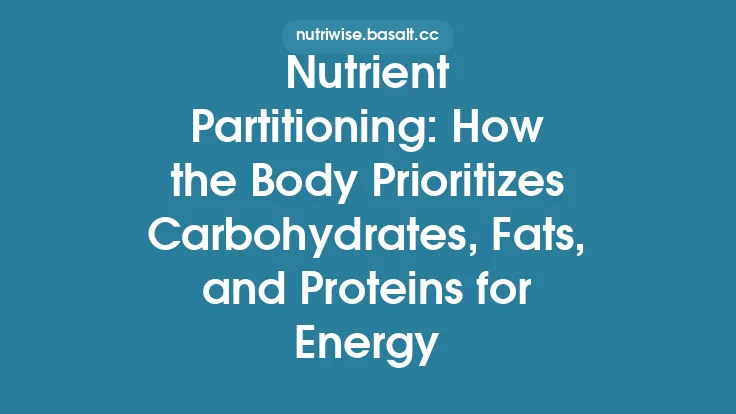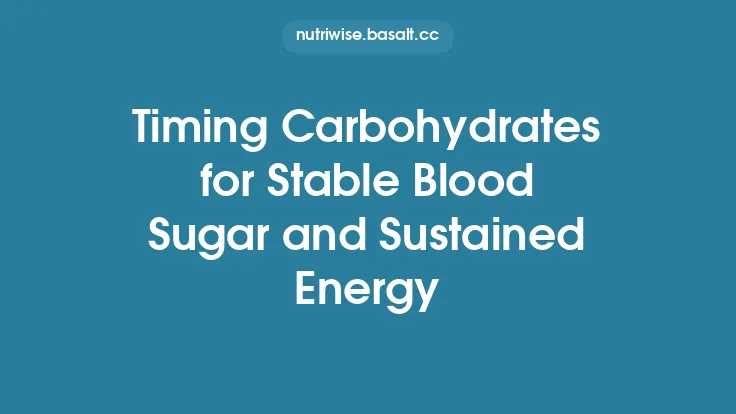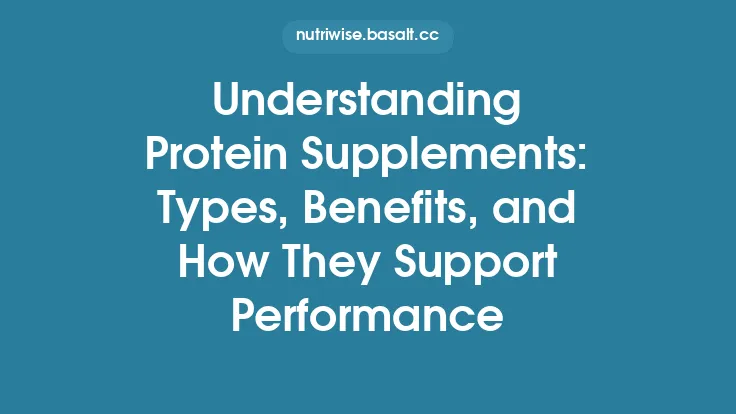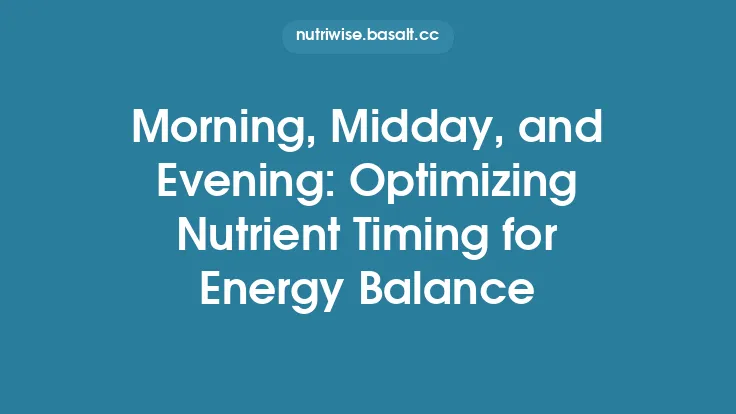Carbohydrates are the primary source of rapid, readily‑available energy for the human body, and their influence on both everyday energy levels and athletic performance is profound. When we consume carbohydrate‑rich foods, glucose enters the bloodstream and becomes the fuel that powers every cell, especially the skeletal muscles that drive movement. Understanding how this macronutrient is stored, mobilized, and oxidized provides the foundation for optimizing energy availability during daily activities and training sessions. Below, we explore the biochemical pathways, storage mechanisms, and practical strategies that link carbohydrate intake to performance outcomes, while staying focused on the core science that underpins these relationships.
Metabolic Pathways: From Glucose to ATP
The conversion of carbohydrate into usable energy follows a well‑defined cascade:
- Glycolysis – In the cytosol of muscle and other cells, a single glucose molecule is broken down into two molecules of pyruvate, yielding a net gain of 2 ATP and 2 NADH. This pathway operates anaerobically, meaning it does not require oxygen, and can proceed at high rates during intense, short‑duration efforts.
- Pyruvate Oxidation and the Citric Acid Cycle – When oxygen is plentiful, pyruvate is transported into the mitochondria, where it is converted to acetyl‑CoA. Acetyl‑CoA then enters the citric acid (Krebs) cycle, generating additional NADH and FADH₂, which feed electrons into the electron transport chain.
- Oxidative Phosphorylation – The electron transport chain uses the high‑energy electrons from NADH and FADH₂ to pump protons across the inner mitochondrial membrane, creating a proton gradient that drives ATP synthase. This process yields approximately 30–32 ATP per glucose molecule, making it the most efficient way to harvest energy from carbohydrates.
The balance between glycolysis (anaerobic) and oxidative phosphorylation (aerobic) shifts depending on exercise intensity, oxygen availability, and the athlete’s training status. Understanding this balance is key to tailoring carbohydrate intake for specific performance goals.
Glycogen Stores: The Body’s Immediate Energy Reservoir
Glucose that is not immediately needed for energy is polymerized into glycogen, a highly branched polysaccharide stored primarily in two locations:
- Skeletal Muscle Glycogen – Each kilogram of muscle can hold roughly 300–400 g of glycogen, providing a localized fuel source that can be rapidly mobilized during contraction. Because muscle glycogen is not shared with other tissues, it directly supports muscular work.
- Hepatic (Liver) Glycogen – The liver stores about 100 g of glycogen, which serves to maintain blood glucose levels during fasting periods and between meals. Liver glycogen can be broken down (glycogenolysis) and released as glucose into the bloodstream, supplying the brain and other glucose‑dependent organs.
Both stores are finite. Depletion of muscle glycogen is a primary factor in the onset of fatigue during prolonged or high‑intensity exercise, while low liver glycogen can impair the ability to sustain blood glucose, leading to a drop in central nervous system (CNS) arousal and perceived effort.
Carbohydrate Utilization Across Exercise Intensities
The proportion of energy derived from carbohydrates versus fats changes dramatically with exercise intensity:
| Exercise Intensity (Relative to VO₂max) | Primary Fuel Source | Approximate Carbohydrate Contribution |
|---|---|---|
| < 45 % VO₂max (low‑intensity) | Predominantly fat | 30–40 % |
| 45–65 % VO₂max (moderate) | Mixed (fat + carb) | 50–60 % |
| 65–85 % VO₂max (high) | Predominantly carb | 70–80 % |
| > 85 % VO₂max (very high) | Near‑exclusive carb | 85–95 % |
At low intensities, the body can meet most of its ATP demand through β‑oxidation of fatty acids, sparing glycogen. As intensity rises, the rate of ATP turnover exceeds the capacity of fat oxidation, forcing a greater reliance on carbohydrate metabolism because glycolysis can produce ATP more rapidly, albeit less efficiently. This shift explains why athletes feel a “burn” and experience rapid fatigue when glycogen stores become limited during high‑intensity work.
Pre‑Exercise Carbohydrate Strategies for Optimal Performance
Consuming carbohydrates before activity serves two main purposes: topping off muscle glycogen and elevating blood glucose to provide an immediate substrate for the CNS and working muscles. Key considerations include:
- Timing – A carbohydrate‑rich meal (1–4 g·kg⁻¹ body mass) consumed 3–4 hours before exercise allows for gastric emptying, digestion, and glycogen synthesis. A smaller snack (0.5–1 g·kg⁻¹) 30–60 minutes prior can raise blood glucose without causing gastrointestinal discomfort.
- Quantity – For most endurance events lasting > 90 minutes, pre‑exercise carbohydrate intake of 1–2 g·kg⁻¹ is sufficient to maximize muscle glycogen stores. Strength‑oriented sessions may benefit from a modest carbohydrate dose (0.5–1 g·kg⁻¹) to support high‑intensity bursts.
- Form – Simple sugars (e.g., glucose, sucrose) are rapidly absorbed, while more complex carbohydrates (e.g., maltodextrin) provide a steadier release. The choice depends on individual tolerance and the timing window.
During‑Exercise Carbohydrate Fueling: Timing and Formulation
When exercise extends beyond 60 minutes, endogenous glycogen becomes insufficient to sustain high rates of carbohydrate oxidation. Exogenous carbohydrate ingestion can replenish the supply and delay fatigue. Effective intra‑exercise fueling follows these principles:
- Rate of Intake – 30–60 g of carbohydrate per hour is the general guideline for most athletes. Trained individuals can tolerate up to 90 g·h⁻¹ when using multiple carbohydrate types (e.g., glucose + fructose) that exploit different intestinal transporters.
- Carbohydrate Type – Glucose (or maltodextrin) is absorbed via the sodium‑glucose linked transporter (SGLT1). Adding fructose, which uses the GLUT5 transporter, allows for higher total carbohydrate absorption without overwhelming a single pathway.
- Form – Liquid solutions are absorbed faster than gels or solid foods, but gels can be convenient for athletes who prefer a more concentrated source. The solution’s osmolality should be isotonic (≈ 300 mOsm·kg⁻¹) to minimize gastrointestinal distress.
- Timing – Begin ingestion early (within the first 15–30 minutes) and continue at regular intervals (e.g., every 15–20 minutes) to maintain a steady plasma glucose concentration.
Post‑Exercise Carbohydrate Replenishment and Recovery
After strenuous activity, rapid glycogen resynthesis is essential for subsequent training sessions and for supporting muscle repair processes. The post‑exercise window (the first 2 hours) is characterized by heightened insulin sensitivity and increased activity of glycogen synthase, making it an optimal period for carbohydrate intake.
- Quantity – 1.0–1.5 g·kg⁻¹ body mass per hour for the first 4 hours can restore 60–80 % of depleted muscle glycogen. For athletes with multiple daily sessions, higher intakes (up to 2.0 g·kg⁻¹·h⁻¹) may be warranted.
- Carbohydrate‑Protein Combination – Adding 0.2–0.3 g·kg⁻¹ protein to carbohydrate (a 3:1 or 4:1 carbohydrate‑to‑protein ratio) can further stimulate insulin release and promote muscle protein synthesis, enhancing overall recovery.
- Timing – Immediate consumption (within 30 minutes) maximizes glycogen synthesis rates; however, total daily carbohydrate intake remains the dominant factor for full restoration.
Carbohydrate Periodization: Matching Fuel to Training Demands
Just as training variables (volume, intensity, frequency) are periodized, carbohydrate intake can be strategically varied to align with specific training phases:
| Training Phase | Goal | Carbohydrate Strategy |
|---|---|---|
| Base/Low‑Intensity | Build aerobic capacity, promote metabolic flexibility | Moderate carbohydrate (3–5 g·kg⁻¹·day⁻¹), emphasis on mixed sources |
| High‑Intensity/Competition | Maximize performance, sustain high power output | High carbohydrate (6–10 g·kg⁻¹·day⁻¹), focus on rapid‑digesting forms before and during sessions |
| Recovery/Transition | Facilitate glycogen restoration, support tissue repair | Elevated carbohydrate (≥ 7 g·kg⁻¹·day⁻¹) combined with protein, timing optimized around workouts |
| Low‑Carbohydrate/Adaptation | Enhance fat oxidation, improve metabolic efficiency | Reduced carbohydrate (< 3 g·kg⁻¹·day⁻¹) for selected training blocks, ensuring adequate energy from fats |
Periodization allows athletes to avoid chronic high carbohydrate intake when it is not needed, while still ensuring that glycogen stores are ample for sessions that demand maximal output.
Central Nervous System Effects: Glucose and Perceived Effort
Beyond peripheral muscle metabolism, glucose plays a pivotal role in brain function during exercise. The CNS relies almost exclusively on glucose for energy, and fluctuations in blood glucose can influence:
- Cognitive Performance – Decision‑making, reaction time, and motor coordination are sensitive to glucose availability. Even modest hypoglycemia can impair these functions, compromising technical execution in sport.
- Perceived Exertion – Studies show that maintaining stable blood glucose reduces ratings of perceived exertion (RPE) at a given workload, likely because the brain receives sufficient fuel to sustain arousal and motivation.
- Central Fatigue Theory – Low glucose may increase the synthesis of serotonin in the brain, promoting a sense of tiredness. Adequate carbohydrate intake can mitigate this effect, allowing athletes to sustain higher intensities for longer.
These central mechanisms underscore why carbohydrate strategies that stabilize blood glucose—both before and during exercise—are essential for optimal performance, not merely for muscle fuel.
Practical Guidelines for Athletes and Active Individuals
- Assess Your Training Demands – Identify the duration, intensity, and frequency of your sessions to estimate carbohydrate needs.
- Plan Pre‑Exercise Meals – Aim for 1–2 g·kg⁻¹ carbohydrate 3–4 hours before long or high‑intensity workouts; add a small 0.5 g·kg⁻¹ snack if the session is within an hour.
- Intra‑Exercise Fueling – For activities > 60 minutes, consume 30–60 g carbohydrate per hour, using glucose + fructose blends if tolerable.
- Post‑Exercise Recovery – Within 30 minutes, ingest 1–1.5 g·kg⁻¹ carbohydrate, optionally paired with 0.2–0.3 g·kg⁻¹ protein.
- Periodize Carbohydrate Intake – Align higher carbohydrate days with high‑intensity or competition phases; lower intake during low‑volume, endurance‑building periods.
- Monitor Individual Tolerance – Gastrointestinal comfort, personal glucose response, and training adaptations vary; adjust types and timing accordingly.
- Stay Hydrated – Carbohydrate solutions contribute to fluid intake; ensure total fluid balance matches sweat losses.
Future Directions and Emerging Research
Research continues to refine our understanding of carbohydrate’s role in performance:
- Exogenous Ketone‑Carbohydrate Blends – Investigations explore whether adding ketone esters to carbohydrate feeds can further spare glycogen and enhance endurance capacity.
- Genetic Influences – Polymorphisms in genes related to carbohydrate metabolism (e.g., AMPK, PFK) may dictate individual responsiveness to carbohydrate loading strategies.
- Neurocognitive Carbohydrate Supplementation – Emerging work examines targeted glucose delivery to the brain (e.g., nasal sprays) to improve decision‑making under fatigue.
- Microbiome Interactions – While beyond the scope of this article, early data suggest gut microbial composition may affect carbohydrate utilization efficiency during exercise.
Continued advances will likely yield more personalized carbohydrate recommendations, integrating metabolic profiling, genetics, and real‑time monitoring technologies.
By grasping the biochemical foundations of how carbohydrates are stored, mobilized, and oxidized, athletes and active individuals can make informed decisions about when and how much to consume. Tailoring carbohydrate intake to the specific demands of training and competition not only sustains energy levels and delays fatigue but also supports recovery, cognitive function, and long‑term performance progression.





